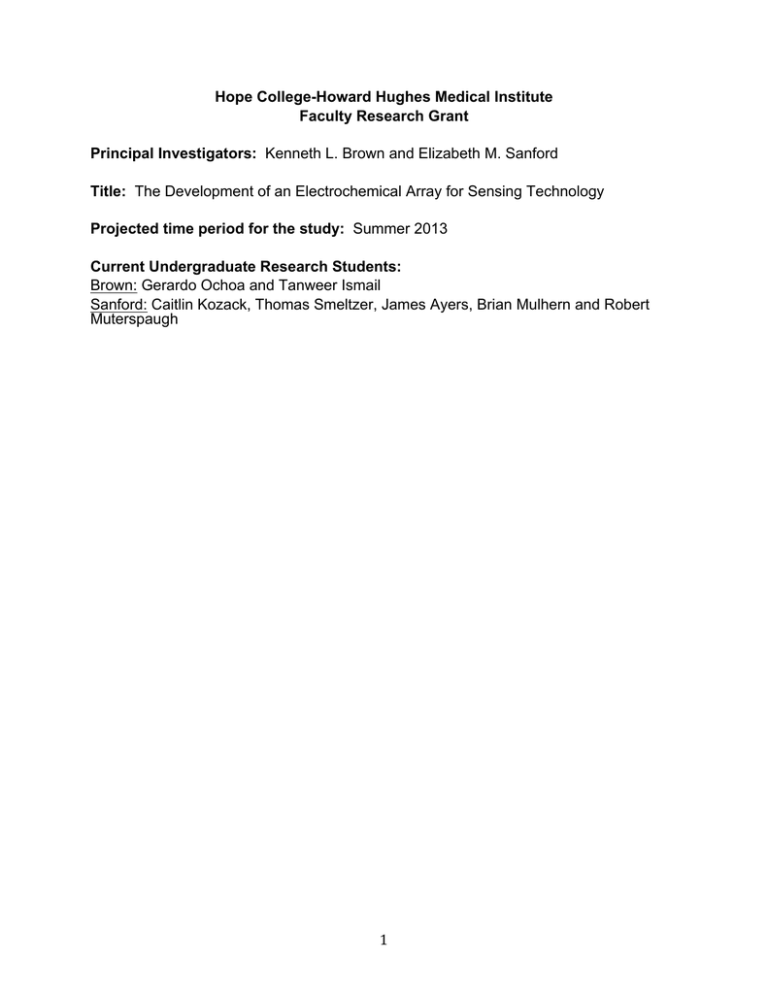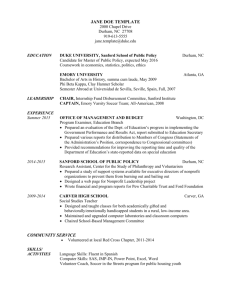Hope College-Howard Hughes Medical Institute Faculty Research Grant Principal Investigators:
advertisement

Hope College-Howard Hughes Medical Institute Faculty Research Grant Principal Investigators: Kenneth L. Brown and Elizabeth M. Sanford Title: The Development of an Electrochemical Array for Sensing Technology Projected time period for the study: Summer 2013 Current Undergraduate Research Students: Brown: Gerardo Ochoa and Tanweer Ismail Sanford: Caitlin Kozack, Thomas Smeltzer, James Ayers, Brian Mulhern and Robert Muterspaugh 1 Abstract: An artificial or electronic tongue is an electrochemical array of nonspecific sensors that measure responses to a liquid medium. In the past 15 years techniques in chemistry, molecular biology and computing have advanced enough that electronic or artificial tongues have been prepared and some have even been commercialized. That broad array of responses is then processed based on pattern recognition and/or multivariate data analysis to identify the substance. This data analysis of electrochemical measurements is called chemometrics. To make the biological analogy the electrochemical sensors are the physical tongue and the data analysis is the brain. Together they can taste artificially. It is our desire to develop electrochemical sensors that can be used as artificial tongues when analyzed using chemometrics by preparing functionalized ethylenedioxythiophene (EDOT) films on electrodes and then measuring their response to different stimuli and analyzing the data using known chemometric processes. 2 Project Description Significance of work: The significance of this work is to develop electrochemical sensing technology through collaborative research in organic chemistry and electroanalytical chemistry and to develop future STEM research leaders through their participation in undergraduate research. This work also opens a new research area in our groups that will require preliminary results to succeed in obtaining external funding. If successful it will also open the possibility of future collaborations with colleagues in computer science. Objectives: The Sanford group has been working in the area of highly conjugated polymers for a number of years. Electropolymerized ethylene dioxythiophene (EDOT/PEDOT) is such a material (Figure 1). The Sanford and Brown groups have been working on building a joint research area in which the Sanford group prepares functionalized EDOT monomers with a variety of sensing groups attached to them. O O The Brown group then makes PEDOT films via electropolymerization and measures and characterizes the S electrochemical response. After reading recent work on the 1 development of electronic tongues it became clear to us that EDOT we could use many of the existing and planned monomers in O O our group to enter the artificial tongue area. For example, S S the Suslick group uses a variety of dyes, redox active S compounds like porphpyrins and metal salts, all nonspecific O O O O sensors that are analyzed chemometrically, to sense toxic industrial chemicals, foods and even bacteria. The Suslick polyEDOT (PEDOT) group does this using color, not electrochemistry. Their Figure 1. EDOT and PEDOT Structures work, however, suggests that the color sensitivity would translate to electrochemical activity. The Sanford and Brown groups have prepared EDOT monomers attached to both dyes and redox active molecules that are very similar to the materials the Suslick group uses. We are in a great position to make films from these monomers on electrodes and prepare an artificial tongue. This work will provide superb training for future STEM leaders because students will first start participating during a course based research experience in Organic Independent Projects (CHEM 256) and then continue to a summer research position in synthesis and/or electrochemistry. These students will interact with each other and other group members in a collaborative manner. In addition they will participate in the professional development activities that are a part of our summer research program in chemistry and then disseminate the results with posters, talks and publications. This work will also provide preliminary data for an external grant to support our electronic tongue efforts. Methods: Two undergraduate students will prepare substituted thiophene monomers as part of our course-based research in CHEM 256, Organic Independent Projects. These students will be trained in how to search the chemical literature, develop a project and write a short proposal. They will also be trained in the practical aspects of research by ordering chemicals, analyzing safety and toxicity of compounds they will be using and designing the experiments that need to be done. The overall goal of their proposal will be to execute a three-step synthesis of a thiophene monomer for the electronic tongue project. One of these students will continue during the summer on the synthetic side of the project and the other will specialize in the electrochemical side. n 3 Synthetic Methods: The synthetic portion of the project involves preparing monomers for electropolymerization. Each monomer involves a multistep synthesis. Some monomers have been completed and others are in process. The student involved in this research will either begin a new monomer or finish an existing monomer depending on the success of syntheses undertaken as part of CHEM 256. Each monomer preparation involves training in multistep organic synthesis. This training is critical for success in graduate school in organic chemistry. Figure 2 shows the compounds that we plan to O O prepare and use to fabricate an electronic tongue. Fe O These compounds are redox active compounds, 2 S dyes and ion sensitive compounds. We have taken EDOT-substituted ferrocene such compounds and attached them to an electropolymerizable EDOT moiety so that we can form a sensing film of each compound on an OR electrode. Allthough none of these compounds is selective for a particular substrate together as an array they can become selective just as the tongue becomes selective with only a few nonselective N N sensors. Compounds 2 and 3 are redox active OR Fe RO compounds. Compound 2 has been made but not N N electropolymerized. Compound 3 is in the process of being synthesized. Compound 4 is a fluorescent dye that is also electrochromic. This compound has been made, and stable films have been formed from S O it. Variations of its design are being explored for EDOT-substituted OR porphyrin new targets. Compound 5 is a solvatochromic dye O 3 R= CH2CH2CH2CH2O that changes color depending on the polarity of the environment that is in. A synthetic route has been worked out to prepare this compound, but its S synthesis is not complete. Compound 6 has been S O O made, but not electropolymerized. It is capable of O binding cations. Our goals is to use four of these N N compounds, polymerized on 4 different electrodes, O O O to demonstrate the proof of principle for the S electronic tongue. The fact that these compounds S 4 range in readiness for electropolymerization from EDOT-substituted diketopyrrolopyrrole “done” to “in preparation” will allow the synthesis student and the electrochemistry student to push the project forward simultaneously. As we explore the S R N electrochemistry of these compounds, we will O OH inevitably need to design and prepare new O monomers as well. R= CH2CH2CH2CH2O Electrochemical Methods: The student in charge of 5 the electrochemical side of this project will need to EDOT-substituted Brooker's Merocyanine work out conditions to electropolymerize each of these monomers on a variety of electrode types O O O O using cyclic voltammetry. Once a film is formed it O O needs also needs to be characterized. Students will 6 first use glassy carbon and platinum electrodes as S the platform to make the polymer coatings. EDOT-substituted polyether Ultimately these sensors will then need to be Figure 2. Monomers for individual electrode sensors arranged in an array interfaced with appropriate in an electronic tongue array. software and then tested for sensitivity. Our goal for 4 this grant periods is to do sensing of an analyte or group of analytes of interest with each of the electrodes separately and overly their responses. If there is a difference in the overlay of the responses and this is successful, the students will begin to develop the sensor arrays on ceramic-based platinum and gold platforms like that shown in Figure 3. We also have access to a 4 channel potentiostat at Gentex Corporation. A key interest is in the optimization of the polymer film to be used as the sensing element. Cyclic voltammetry and square wave voltammetry will be used as the primary instrumental methods for preparing and characterizing the polymer films respectively. These techniques will provide both qualitative and quantitative information on the performance of the sensor array in response to different analytes. Figure 3. Ceramic-based platinum electrode from Pine Research Instruments. The electrochemistry student will gain experience in analytical chemistry, experiment design, electrochemistry and chemometrics. This training will prepare this student to begin graduate work at a very high level in analytical and materials chemistry. Both the synthetic organic student and the analytical student will be cross trained in synthetic organic chemistry and electrochemistry. The cross training in synthesis will occur during the Independent Projects in CHEM 256. During the summer the organic student will support the electrochemistry efforts by doing the first round of electropolymerizations to test the suitability of the monomers. Having both synthetic organic experience in addition to electrochemistry training will make these students very attractive as potential graduate students for top research groups in applied materials. Both students will be expected to interact throughout the project with each other, both mentors and other group members. Each will prepare and give a poster and talk internally this summer and also give a poster externally to Hope. Each will also be required to participate in an outreach activity with Holland Public Schools (HPS). Expected Outcomes: After the sequence of Independent Projects in CHEM 256 followed by a summer of research students will be at the level of a first year graduate student in chemistry. As such with additional work they should have adequate experience to gain admission to a highly ranked graduate program in chemistry. Students will be encourage to complete an additional summer of research either at Hope or a research focused university to further prepare for graduate school. We expect to be able to prepare four stable electrodes by the end of the summer and demonstrate cooperate sensing. At this stage a proof of principle is the goal. Preliminary results will be used to apply for external grants. Potential Difficulties: It is possible that one or more of the monomers will fail to electropolymerize or that films once formed will not be stable. Because each synthesis is not very long and more than four monomers are planned we expect we will overcome this inevitable barrier. 5 Demonstrating the array without a true array by overlaying spectra could be a challenge. We are prepared to collaborate with other groups with electrochemical array technology in place to better demonstrate proof of principle. Because this project is very new and meant to provide preliminary data, there will be significant work to do after the grant period. Connections to other HHMI 2012 Programs: The students involved in this project will be trained to become future STEM research leaders. They will begin their research during an existing course based research experience in CHEM 256. If they are interested in academic careers they will be encouraged to participate in the mentoring workshops run by the HHMI Research Scholars Program. In addition the faculty and students supported by this proposal will do an outreach program (50 minute demonstration) for middle school students at Holland Public Schools Jefferson K-7 and offer on site “afternoon in the lab” experience for a 6th and a 7th grade student who has shown aptitude and interest in the sciences but lacks exposure to such opportunities. This school has a large underrepresented minority student body and serves a large number of economically disadvantaged students. This experience will teach these future leaders about how to communicate science to younger students and allow them to see the needs of our K-12 community. Our experience in taking many of our Hope students to volunteer at HPS is that they are amazed at the ethnic and economic diversity in HPS and the enthusiasm of the students encourages them to participate in other K-12 outreach. We hope that including this in our research plan shows that K-12 outreach should be a lifetime commitment of a future STEM researcher. Future Funding: The Sanford and Brown groups intend to apply for an NSF RUI to support this work in the fall of 2013. We are also looking into EPA support. Timeline: March 26: Independent Synthesis Projects: Students begin the preparation of Monomers May 13-July 19: Summer Research: Synthetic student prepares monomers after assessment of feasibility from Independent Synthesis; Electrochemistry student prepares 4 electrodes for array. Demonstration of array planned to begin by the end of the summer research period and into the following school year. Students will participate in professional training program that is part of summer research and present both papers and posters internally July 19-October 31: Preparation of proposal for NSF RUI/Continuation of both the synthetic and electrochemistry projects Students will also present at an external to Hope research meeting such as the Van Andel Institute or the Midstates Consortium in the fall of 2013 or an equivalent meeting. 6 Bibliography Del Valle, m. “Electronic Tongues Employing Electrochemical Sensors” Electroanalysis 2010, 22(14), 1539. Pigani, L, Foca, G. Ulrici, A., Ionescu, K., Martina, V., Terzi, F., Bignali, M. Zanardi, C. Seeber, R. “Classification of red wines by chemometric analysis of voltammetric signals from PEDOT-modified electrodes” Analytica Chimica Acta 2009, 643, 67. Feng, L., Musto, C. J., Kemling, J. W., Lim, S. H., Zhong, W., Suslick, K. S. “Colorimetric Sensor Array for Determination and Identification of Toxic Industrial Chemicals” Anal. Chem. 2010, 82, 9433. Smyth, H., Cozzolino, D. “Instrumental Methods (Spectroscopy, Electronic Nose, and Tongue) As Tools to Predict Taste and Aroma in Beverages: Advantages and Limitations” Chem. Rev. available online: dx.doi.org/10.1021/cr300076c, not yet in print. 7 Budget Page Faculty Stipends Supplies/Equipment Student Stipends Total Brown 1000 1900 4600 7500 Sanford 1000 1900 4600 7500 Total 2000 3800 9200 15,000 Faculty Stipends: A faculty stipend is requested by both Sanford and Brown in the amount of $1000 each (2 * $1000= $2000) minus the appropriate FICA and MQFE. If this funding cannot be taken as salary due to regulations on other pending funding, it will be used for additional supplies. Supplies/Equipment. Funds for supplies are requested for the Brown group and Sanford group. The Brown group will use the funds to purchase electrodes and electrochemical supplies. The Sanford group will use funds to purchase chemicals to synthesize compounds (approximately 1 g each product is needed for testing to be completed). The thiophene building blocks are expensive compounds. For example hydroxymethyl-EDOT, a building block for all of our monomers is currently $70.00/g. Student assistants: Stipends in the amount of $4600 is requested for two students (2 x $4600= $9200-- FICA deducted from this amount). 8 Biographical Sketch Kenneth L. Brown A. Professional Preparation Oral Roberts University Oklahoma State University Chemistry Chemistry B.S., 1993 Ph.D., 1999 B. Appointments Associate Professor of Chemistry, Hope College, 2006-Present. Assistant Professor of Chemistry, Hope College, 2002-2006. Assistant Professor of Chemistry (Term Position), Hope College, 1999-2002. Teaching Assistant, Department of Chemistry, Oklahoma State University, 1995-1999. Research Assistant, Dowell Schlumberger, 1994-1995. Analytical Chemist, Lab One Analytical, 1993-1994. C. Recent Significant Publications (* indicates undergraduate authors) 1. K. Klunder*, F.A. Hekman, K.L. Brown, and G.F. Peaslee, “A Study of Dissolved Gas Dynamics in Mixed Stream Electrolyzed Water,” Electrochemistry: The Electrochemical Society of Japan, 2012, 80(8), 1-4. 2. K.L. Brown, X. Hou*, O. Banks*, K.A. Krueger*, J. Hinson*, G.F. Peaslee, P.A. DeYoung, S.A. Alger*, J. Benzer*, and T.L. Neils, ”Characterization of Tris(5-amino1,10-phenanthroline) Ruthenium(II/III) Polymer Films Using Cyclic Voltammetry and Rutherford Backscattering Spectrometry,” International Journal of Chemistry, 2011, 3(4), 12-19. 3. K.L. Brown, and S.B. Gray*, “Cyclic Voltammetric Studies of Electropolymerized Films Based on Ruthenium(II/III)Bis(1,10 phenanthroline)(4methyl-4’vinyl-2,2’-bibyridine),” International Journal of Chemistry, 2010, 2, 2,3-9. 4. D.J. Gonthier*, T.J. Sullivan, K.L. Brown, B. Wurtzel*, R. Lawal*, K. VandenOever*, Z. Buchan*, and T.L. Bultman, “Stroma-forming endophyte Epichloe glyceriae provides wound-inducible herbivore resistance to it grass roots”, Oikos, 2008, 177, 629-633. 5. J.S. Pinter*, K.L. Brown, P.A. DeYoung, and G.F. Peaslee, “Amperometric Detection of Hydrazine by Cyclic Voltammetry and Flow Injection Analysis Using Ruthenium Modified Glassy Carbon Electrodes,” Talanta, 2006, 71, 1219-1225. 6. Brown, K.L.; Pinter, J.S*.; Ewing, K.*; Ruch, T.R.*; Ambrose, M.* and Hesselsweet, I.*; “Amperometric Detection of Glucose Involving Electropolymerized Tetraaminophthalocyanine and Ferrocene Films.” Analytical Letters, 2005, 38(5), 769780. 7. Brown, K.L.; Shaw, J.*; Ambrose, M.* and Mottola, H.A. “Voltammetric, Chronocoulometric and Spectroelectrochemical Studies of Electropolymerized Films Based on Co(III/II)-and Zn(II)-4, 9, 16, 23-Tetraaminophthalocyanine: Effect of High pH.” Microchemical Journal, 2002, 72, 285-298. 8. Brown, K.L. and Mottola, H.A. “Voltammetric, Chronocoulometric, and Spectroelectrochemical Studies of Electropolymerized Films Based on Cu(II/I)- 4, 9,16, 23Tetraaminophthalocyanine.” Langmuir, 1998, 14(12), 3411-3417. 9 D. Synergistic Activities (i) Talks 1. Kenneth L. Brown, “The Development of New Electrochemical Probes: Three Dimensional Macroporous Electrodes,” Gentex Corporation, April 20, 2010. 2. Kenneth L. Brown, “Research Opportunities at Hope College: From Electrochemistry to Plant Physiology and Beyond,”Harold Washington College, March 2, 2007. 3. "Fungi, Alkaloids, and Differential Equations: A Multidisciplinary Undergraduate Program at Hope College,” Council on Undergraduate Research, Depauw University, Greencastle, IN, 2006. 4. "Developing the Next Generation of Scientific Leaders Through a Dynamic Trio: Mentoring, Research, and Education," PEW Capstone Experiences Workshop, Chicago, March 4, 2006. 5. Kenneth L. Brown, “Cyclic Voltammetric Studies of Metal(II) Tetraaminophthalocyanine Polymer Thin Films: Electrochemistry at Hope College,” Calvin College, December 2, 2004. E. Collaborators and other Affiliations Professor Tom Higgins (Harold Washington College, Chicago, IL) Professor Tom Neils (Grand Rapids Community College) Dr. Marc Wirtz (PPG Industries, Electrochemical Group, Pittsburgh, PA) Professor Phillip Buhlman (University of Minnesota) Professor Graham Peaslee (Hope College) Professor Thomas Bultman (Hope College) Dr. Jeffrey Hendricks (Biotectix, LLC) Dr. Sarah Richardson-Burns (Biotectix, LLC) Dr. Elizabeth M. Sanford (Hope College) F. Graduate Advisor Horacio A. Mottola (Oklahoma State University-Retired) G. Undergraduate Students Supervised: 45 10 BIOGRAPHICAL SKETCH Elizabeth M. Sanford A. Professional Preparation Smith College University of California, Los Angeles Cornell University Chemistry B.A., 1987 Chemistry Ph.D., 1992 Organic/Polymer Chemistry 1992-1994 B. Appointments: Associate Professor of Chemistry, Hope College, 2000-present Visiting Research Associate (sabbatical), Gentex Corporation, Zeeland, MI, 2000-2001 Assistant Professor of Chemistry, Hope College, 1994-2000 C. Significant Publications: (* indicates undergraduate author) 1. M. R. Roslaniec, E. M. Sanford, “Benzoylation of Ergosterol through Nucleophilic Acyl Substitution and Subsequent Formation of Ergosterol Benzoate Endoperoxide by Reaction with Singlet Oxygen Generated by Photosensitization” J. Chem. Ed. 2011, 88(2), 229-131 2. E. M. Sanford, C. C. Lis*, N. R. McPherson*, “The Preparation of Allyl Phenyl Ether and 2-Allyl Phenol Using the Williamson Ether Synthesis and Claisen Rearrangement” J. Chem. Ed. 2009, 86(12), 1422-1423. 3. E. M. Sanford, T. L. Smith, “The Preparation and Enzymatic Hydrolysis of a Library of Esters” J. Chem. Ed. 2008, 85(7), 944-945. 4. T. S. Guarr, K. E. Roberts, R. Lin, K. L. Baumann, D. A. Theiste, P. Giri and E. M. Sanford (Gentex Corporation, Zeeland, Michigan) “Controlled Diffusion Coefficient Electrochromic Materials for use in Electrochromic Mediums and Associated Electrochromic Devices” U. S. Patent 6 710 906, 2004. 5. E. M. Sanford, A. L. Perkins*, B. Tang*, A. M. Kubasiak*, J. T. Reeves*, K. W. Paulisse*, “A Comparison of 1,4-Bis(halomethyl)benzenes as Monomers for the Modified Gilch Route to Poly[2-methoxy-5-((2’-ethylhexyl)-oxy)-p-phenylenevinylene]” Chem. Comm. 1999, 23, 2347-2348. 6. E. M. Sanford, H. Hermann*, “Bromination, Elimination and Polymerization: A 3Step Sequence for the Preparation of Polystyrene from Ethylbenzene” J. Chem. Ed. 2000, 77, 1343-1344. 7. E. M. Sanford, K. W. Paulisse*, J. T. Reeves*, “A Computational Study of 2,5Dibenzylidenecyclopentanone and 2,6-Dibenzylidenecyclohexanone, Model Compounds for Poly(arylidenecycloalkanones)” J. Appl. Poly. Sci. 1999, 74, 2255-2257. 8. K. Pollack, E. M. Sanford, J. M. J. Frechet, "A Comparison of Two Methods for the Preparation of Dendritic Porphyrins: Core Functionalization vs. Porphyrin Assembly" J. Mater. Chem. 1998, 8(3), 519-527. 9. P. J. Dandliker, F. Diederich, A. Zingg, J.-P. Gisselbrecht, M. Gross, Louati, Alain and E. Sanford, "Dendrimers with Porphyrin Cores: Synthetic Models for Globular Heme Proteins" Helvetica Chimica Acta 1997, 80(6), 1773-1801. 10. J. M. J. Frechet, I. Gitsov, R. B. Grubbs, C. J. Hawker, M. Henmi, M. Leduc, E. Sanford and 11 K. Yui, "New Approaches to Dendritic Macromolecules" Polym. Mater. Sci. Eng. 1995, 73, 271272. D. Synergistic Activities •Participant in NSF SSTEM program to transition 2YC students transferring to Hope through a research experience the summer between the 2YC and Hope. •Presentations: E. M. Sanford, M. G. Tori, K. L. Brown, X. Hou, “The Preparation and Electropolymerization of Thiophene-Substituted Diketopyrrolopyrroles,” Bioinspired Materials Gordon Research Conference, Davidson, North Carolina, June 2012 K. Brubaker, E. M. Sanford, M. Tori, R. Muterspaugh, "New Applications for High Performance Dyes," National Organic Symposium, Princeton University, Princeton, New Jersey, June 2011 E. M. Sanford, A. R. Ketchum, E. P. Lauzon, K. L. Brown and X. Hou, “Thiophene Derivatives for Device Applications,” The 33rd Reaction Mechanisms Conference, University of Massachusetts, Amherst, Massachusetts, June 2010 E. M. Sanford, “The Preparation of Highly Conjugated Compounds for Device Applications and the Preparation of Functionalized Sol-Gels for Control of Cell Growth,” Andrews University, Berrien Springs, Michigan, March, 2010 E. Collaborators and other Affiliations Dr. Thomas Neils and Dr. Jennifer Batten (Grand Rapids Community College) Dr. Desmond Murray (Andrews University) Dr. Sarah Richardson-Burns, Dr. Jeffrey Hendricks (Biotectix LLC, An Allied Minds Company) Dr. Kenneth Brown (Hope College) F. Graduate and Postgraduate Advisors Graduate Thesis Advisor, Dr. François N. Diederich (ETH, Zurich, Switzerland) Post-doctoral advisor, Dr. Jean M. J. Fréchet (University of California, Berkeley) G. Undergraduate Research Students Supervised: 65 12 Current and Pending Support Kenneth Brown Current: Collaborative Research: Testing Mutualism Theory Using Endophytic Fungi and Their Host Grass NSF-CRUI; DEB-Pop & Community Ecol. Cluster $280,290; 09/01/11 – 08/31/14 Co PI with Thomas Bultman REU Site: Professional Excellence and Development Through Undergraduate Research NSF-REU CHEM $185,000: 05/01/09 – 09/30/13 Co PI with Graham Peaslee and Elizabeth Sanford Pending: REU Site: Achieving the Next Level—Research Experiences for Underserved Populations NSF-REU CHEM $285,732: 05/01/13 – 04/30/16 Co PI with Graham Peaslee and Elizabeth Sanford GOALI: Probing Interfaces—A Collaboration Between Academics and Industry NSF-Polymers $446,816: 05/01/13 – 04/30/16 Co PI with Elizabeth Sanford Elizabeth Sanford Current: REU Site: Professional Excellence and Development Through Undergraduate Research NSF-REU CHEM $185,000: 05/01/09 – 09/30/13 Co PI with Graham Peaslee and Kenneth Brown Faculty/Student Development Grant: The Development of an Artificial Tongue for Sensing Applications Nyenhuis Faculty Development Grant 13 $7000: 05/13/13 – 08/19/13 (Student collaborator: Brian Mulhern) Pending: REU Site: Achieving the Next Level—Research Experiences for Underserved Populations NSF-REU CHEM $285,732: 05/01/13 – 04/30/16 Co PI with Graham Peaslee and Kenneth Brown GOALI: Probing Interfaces—A Collaboration Between Academics and Industry NSF-Polymers $446,816: 05/01/13 – 04/30/16 Co PI with Kenneth Brown 14






